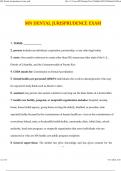MN Dental Jurisprudence Exam-.pdf file:///C:/Users/HP/Desktop/New%20folder/MN%20Dental%20Juris
MN DENTAL JURISPRUDENCE EXAM
1. TERMS:
2. person: includes an individual, corporation, partnership, or any other legal entity
3. state: when used in reference to a state other than MN, means any other state of the U.S.,
District of Columbia, and the Commonwealth of Puerto Rico
4. CODA stands for: Commission on Dental Accreditation
5. Dental health care personnel (DHCP): individuals who work in a dental practice who may
be exposed to body fluids such as blood or saliva
6. assistant: any person who assists a dentist in carrying out the basic duties of a dental office
7. health care facility, program, or nonprofit organization includes: hospital; nursing
home; home health agency; group home serving the elderly, disabled, or juveniles; state
operated facility licensed by the commissioner of human health ser- vices or the commissioner of
corrections; federal, state, or local public health facility, community clinic, tribal clinic, school
authority, head start program, or nonprofit organization that saves individuals who are
uninsured or who are MN health care public program recipients
8. General supervision: The dentist has prior knowledge and has given consent for the
1 of 133 9/13/2024, 5:05
,MN Dental Jurisprudence Exam-.pdf file:///C:/Users/HP/Desktop/New%20folder/MN%20Dental%20Juris
procedures being performed during which the dentist is not required to be present in the
dental office or on the premises
9. Indirect supervision: The dentist is in the office, authorizes the procedures, and remains in
the office while the procedures are being performed by the allied dental personnel
10. Direct supervision: The dentist is in the dental office, personally diagnoses the condition to
be treated, personally authorizes the procedure, and before dismissal of the patient, evaluates
the performance of the allied dental personnel
11. Personal Supervision: The dentist is personally operating on a patient and authorizes the
allied dental personnel to aid in treatment by concurrently performing supportive procedures
12. Public health supervision: A type of supervision in which a licensed dental hy- gienist may
provide dental hygiene services, as specified by state law or regulations, when such services are
provided as part of an organized community program in various public health settings, as
designated by state law, and with general oversight of such programs by a licensed dentist
designated by the state
13. Medical emergency: Medically necessary care which is immediately needed to preserve
life, prevent serious impairment to bodily functions, organs, or parts, or prevent placing the
physical or mental health of the patient in serious injury
14. Patient: A natural person who has received healthcare services from a provider for the
2 of 133 9/13/2024, 5:05
,MN Dental Jurisprudence Exam-.pdf file:///C:/Users/HP/Desktop/New%20folder/MN%20Dental%20Juris
treatment or examination of a medical, psychiatric, or mental condition, the surviving spouse &
parents of a deceased patient or a person that the patient
3 of 133 9/13/2024, 5:05
,MN Dental Jurisprudence Exam-.pdf file:///C:/Users/HP/Desktop/New%20folder/MN%20Dental%20Juris
appoints in writing as a representative
for minors: patient includes a parent or guardian or a person acting as a parent or guardian in
the absence of a parent or guardian
15. analgesia: the diminution or elimination of pain as a result of the administration of an agent
including but not limited to local anesthesia, nitrous oxide, & pharmaco- logical &
nonpharmalogical methods
16. anxiolysis/minimal sedation: has to do w/sedation; a relaxed state & usually the patient
is awake; patient can follow directions or answer questions
17. Deep sedation: a depressed level of consciousness produced by a pharmaco- logical or
nonpharmological method or a combination of both during which patients can't be easily
aroused but respond purposefully following repeated or painful stimulation; characterized by
impairment of the patients ability to independently maintain ventilatory function, spontaneous
ventilation potentially being inadequate to meet a patients needs & the need for assistance in
maintaining a patients airway; patients cardiovascular function doesn't typically require
assistance
18. Enteral: A technique of administration in which the agent is ABSORBED through the
gastrointestinal tract or oral mucosa such as w/ oral, rectal, or sublingual administration
4 of 133 9/13/2024, 5:05




